Abstract
1. The present study tested the hypothesis that the level of xanthine oxidase is elevated in injured human skeletal muscle in association with inflammatory events. Seven male subjects performed five bouts of strenuous one-legged eccentric exercise. Muscle biopsies from both the exercised and the control leg, together with venous blood samples, were obtained prior to exercise and at 45 min, 24, 48 and 96 h after exercise. The time courses of xanthine oxidase immunoreactivity and indicators of muscle damage and inflammation were examined. 2. The number of xanthine oxidase structures observed by immunohistological methods in the exercised muscle was up to eightfold higher than control from day 1 to day 4 after exercise (P < 0.05). The increase was attributed to an enhanced expression of xanthine oxidase in microvascular endothelial cells and an invasion of leucocytes containing xanthine oxidase. 3. The concentration of plasma interleukin-6 was significantly higher 90 min after exercise than before exercise (P < 0.05) and remained higher than pre-exercise levels throughout the 4 days. On day 4 the plasma creatine kinase activity was approximately 150-fold higher (P < 0.05) than resting levels. 4. Despite the increase in xanthine oxidase in the muscle there were no detectable changes in the levels of muscle malondialdehyde or in plasma antioxidant capacity up to 4 days post-exercise. 5. It is concluded that eccentric exercise leads to an increased level of xanthine oxidase in human muscle and that the increase is associated with secondary inflammatory processes. The increase in xanthine oxidase in the muscle occurs mainly in microvascular endothelial cells, but occurs also via infiltrating leucocytes containing xanthine oxidase. A role for leucocytes in xanthine oxidase induction in endothelium is proposed.
Full text
PDF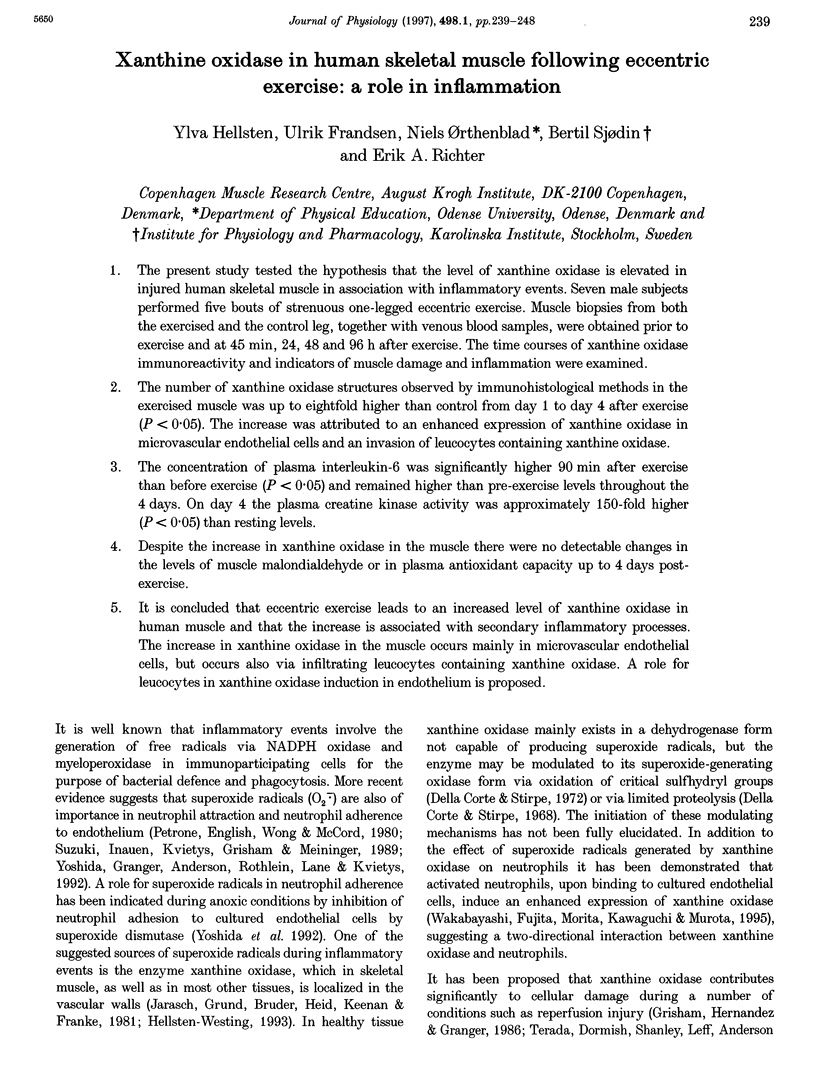
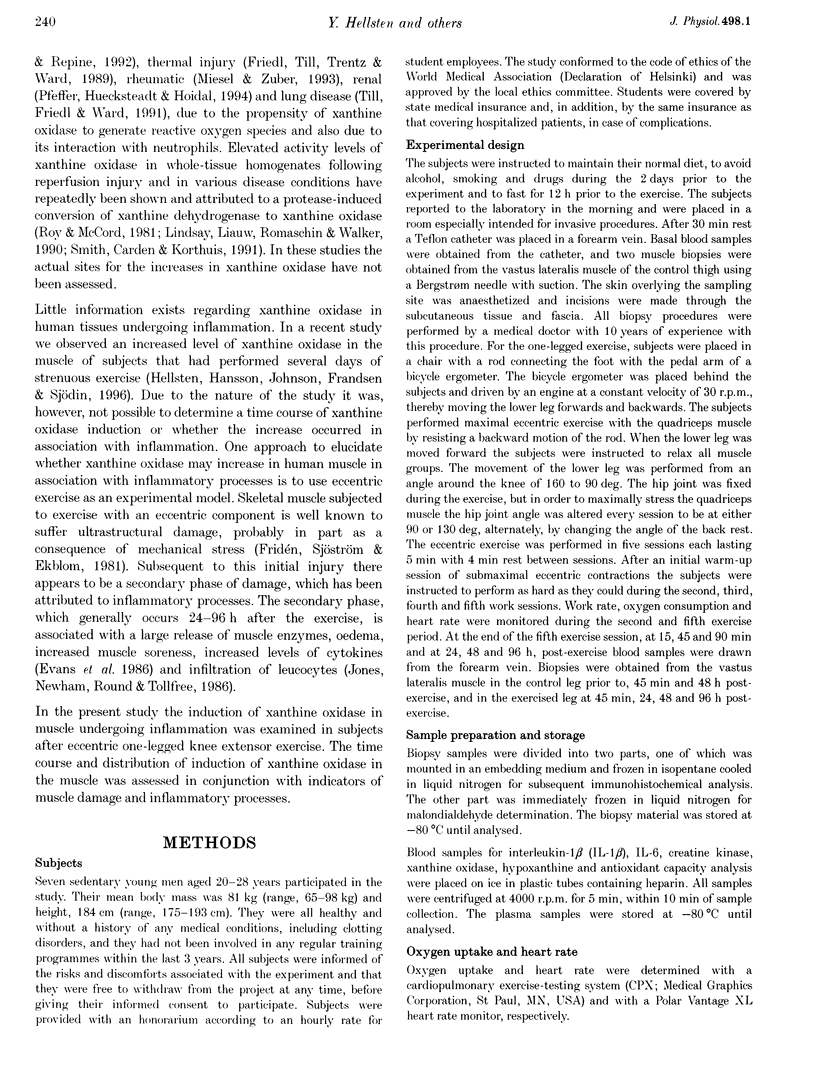
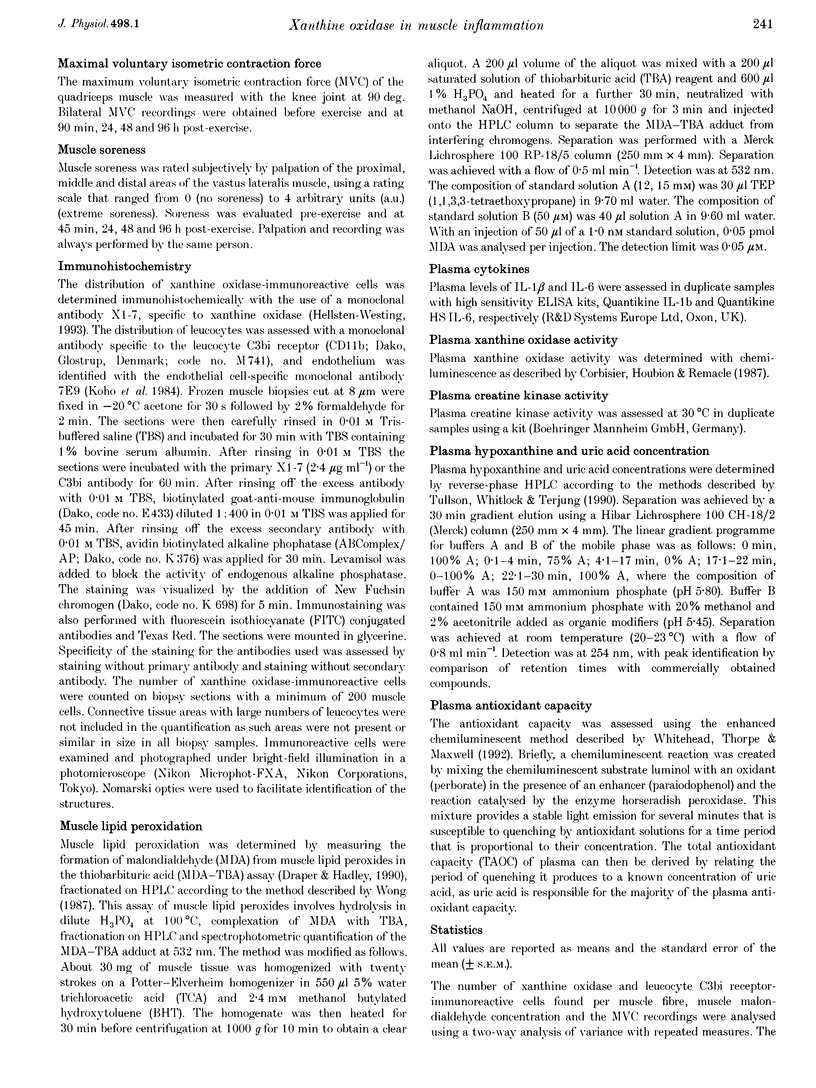
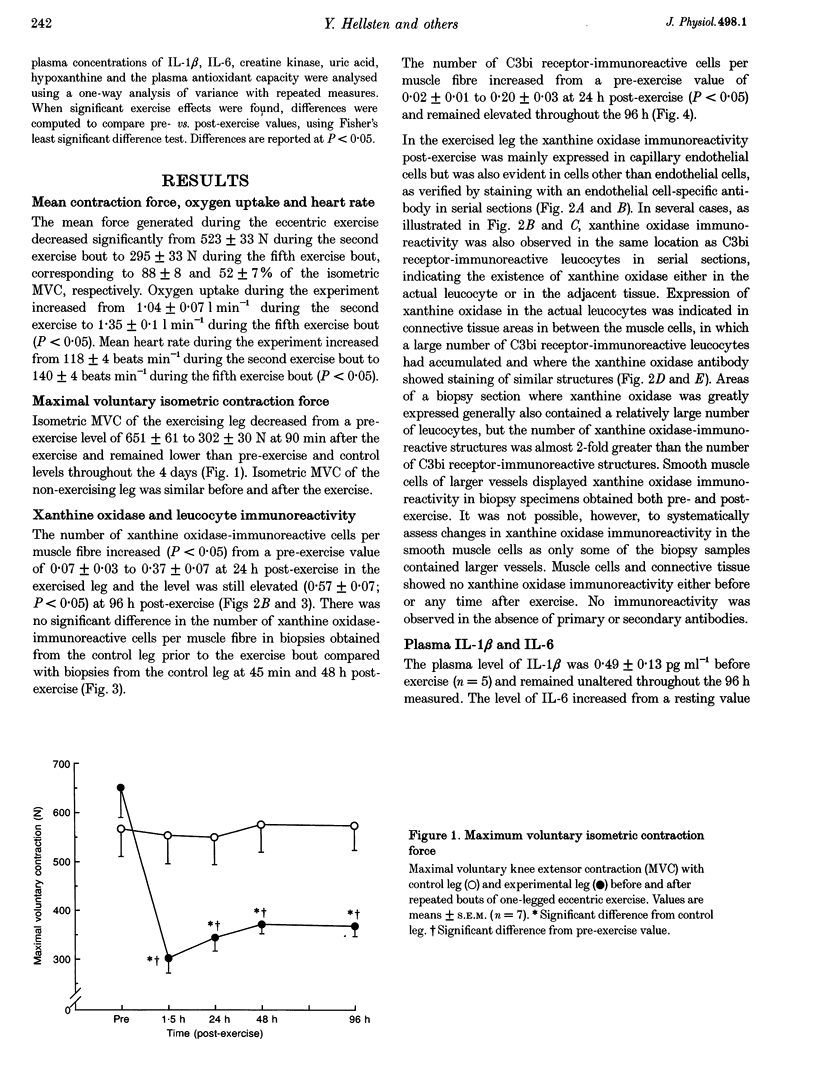
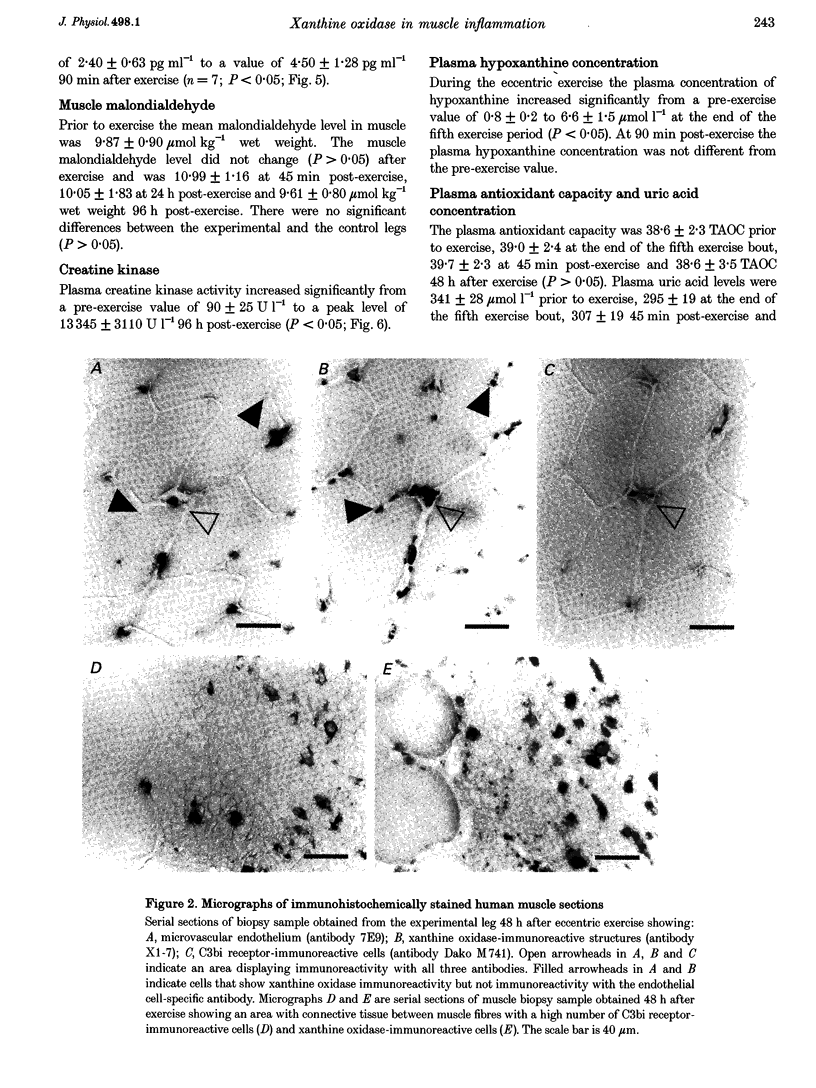
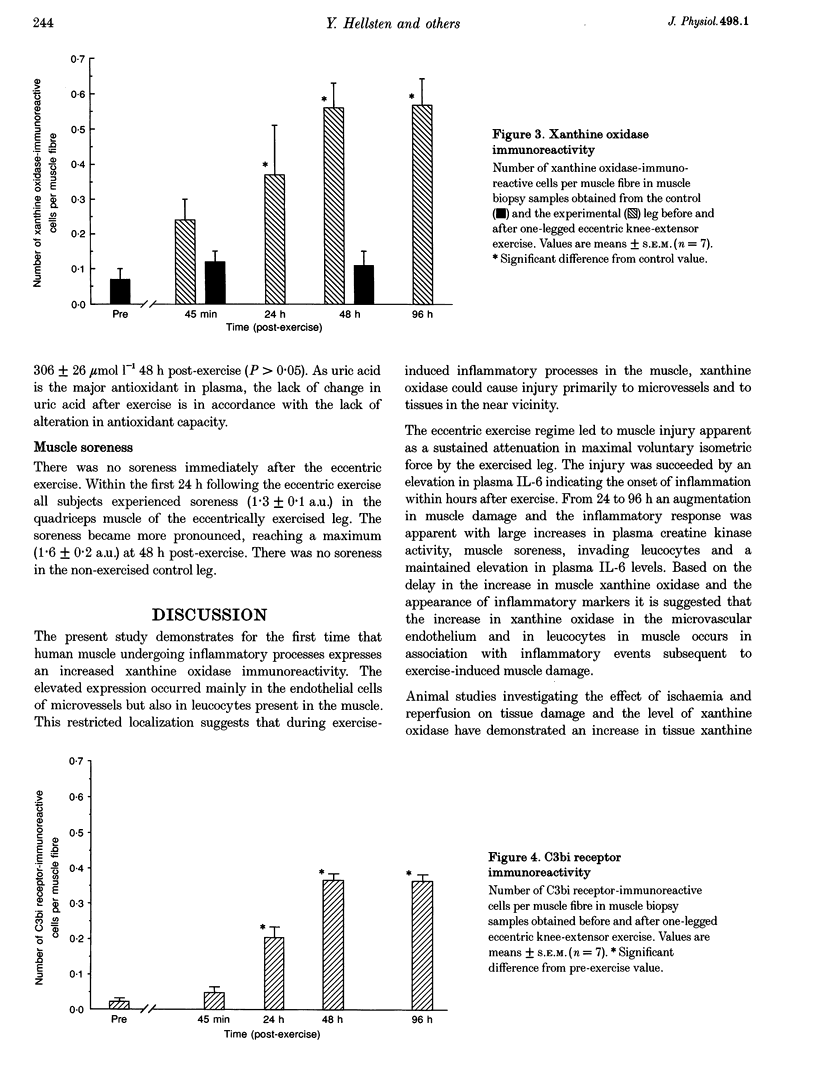
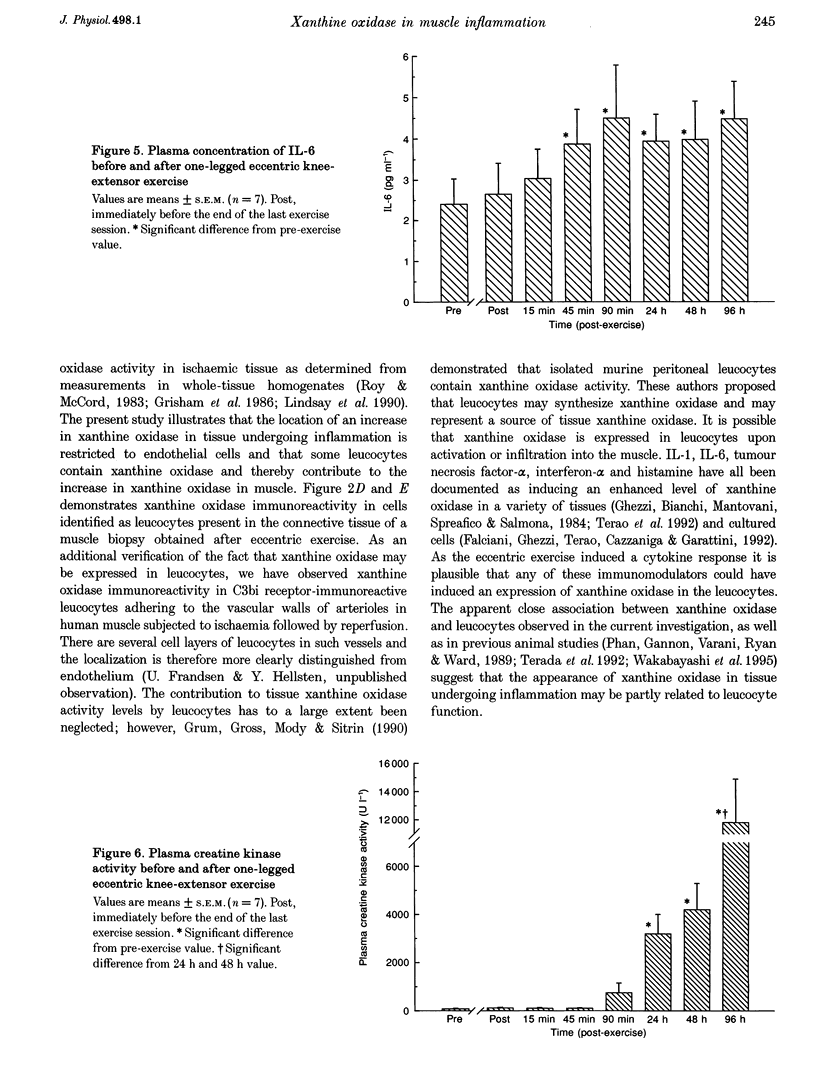
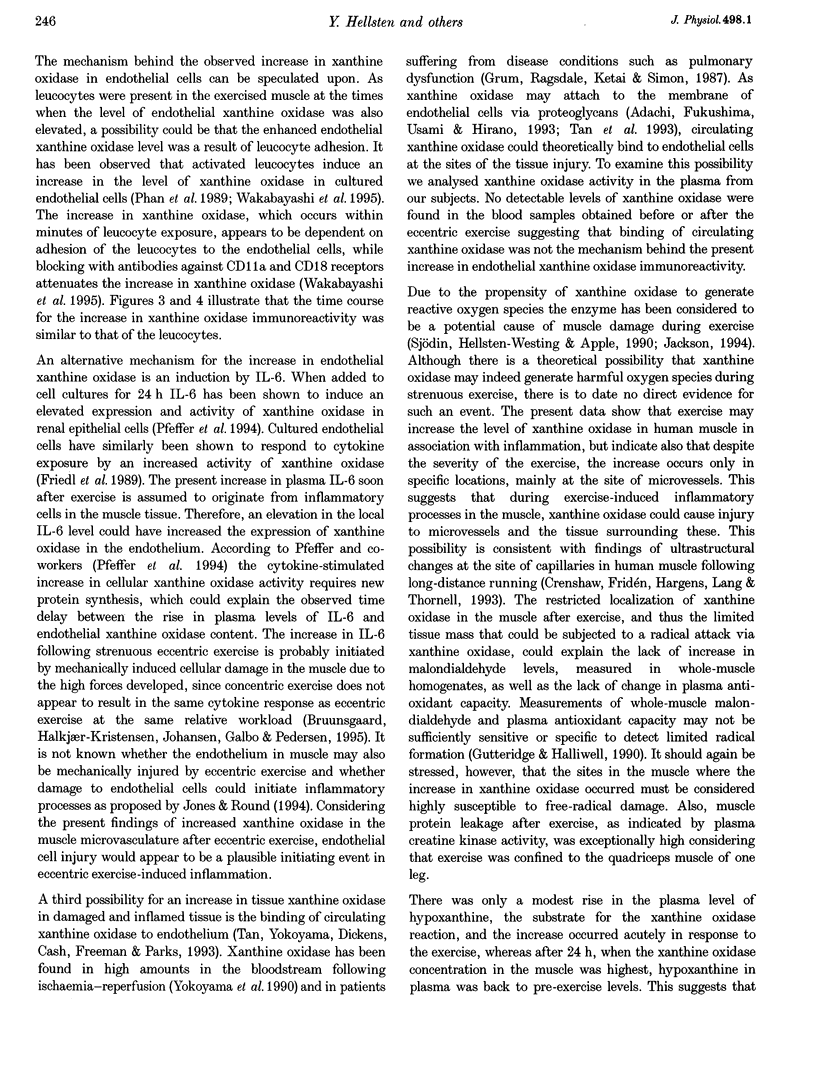
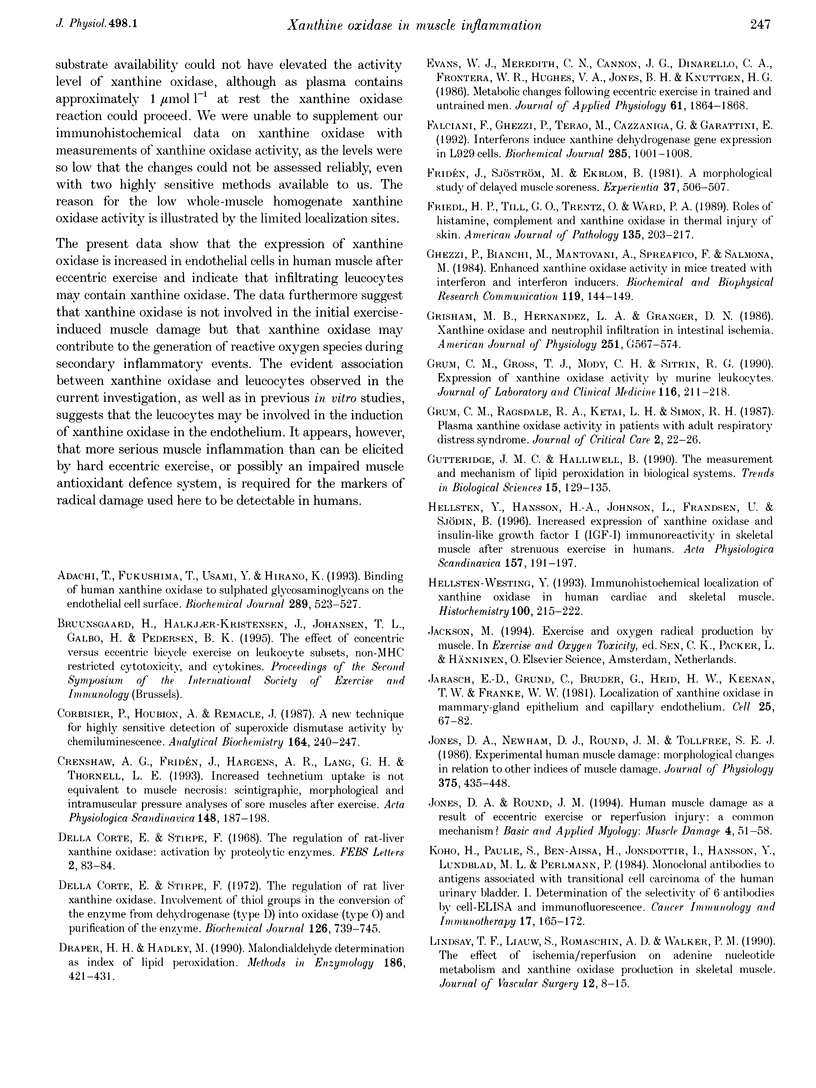
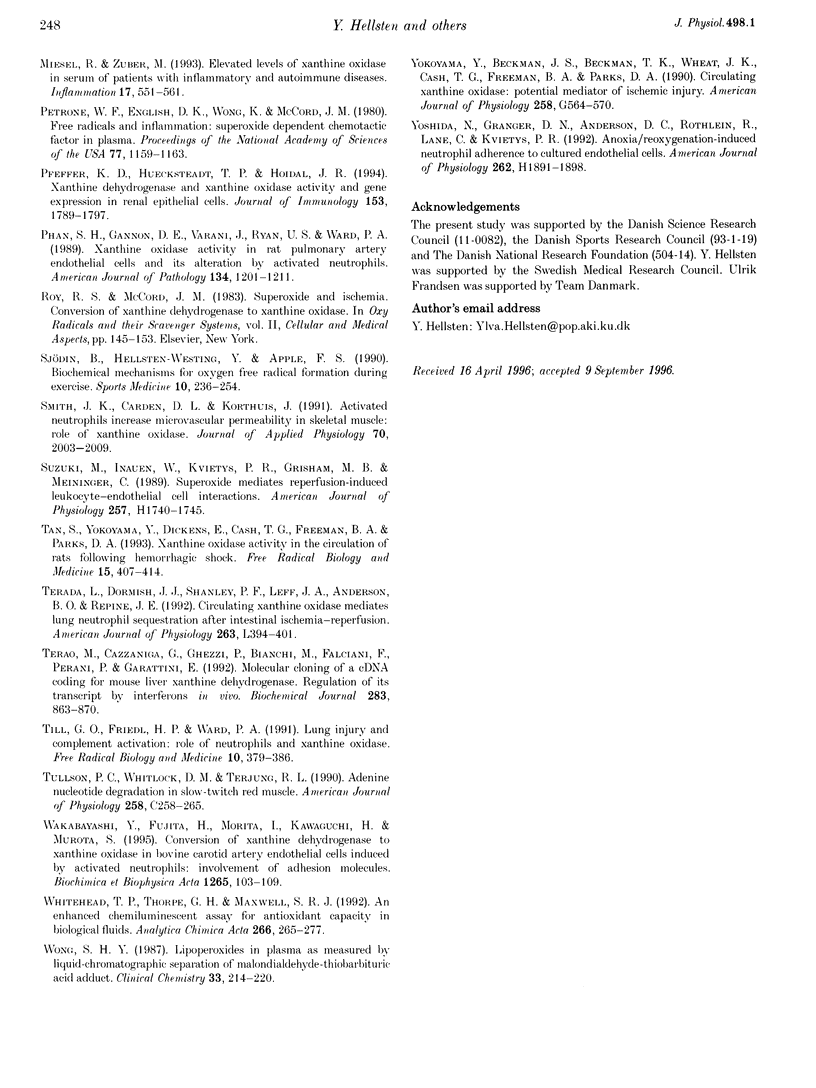
Images in this article
Selected References
These references are in PubMed. This may not be the complete list of references from this article.
- Adachi T., Fukushima T., Usami Y., Hirano K. Binding of human xanthine oxidase to sulphated glycosaminoglycans on the endothelial-cell surface. Biochem J. 1993 Jan 15;289(Pt 2):523–527. doi: 10.1042/bj2890523. [DOI] [PMC free article] [PubMed] [Google Scholar]
- Corbisier P., Houbion A., Remacle J. A new technique for highly sensitive detection of superoxide dismutase activity by chemiluminescence. Anal Biochem. 1987 Jul;164(1):240–247. doi: 10.1016/0003-2697(87)90392-7. [DOI] [PubMed] [Google Scholar]
- Corte E. D., Stirpe F. The regulation of rat liver xanthine oxidase. Involvement of thiol groups in the conversion of the enzyme activity from dehydrogenase (type D) into oxidase (type O) and purification of the enzyme. Biochem J. 1972 Feb;126(3):739–745. doi: 10.1042/bj1260739. [DOI] [PMC free article] [PubMed] [Google Scholar]
- Crenshaw A. G., Fridén J., Hargens A. R., Lang G. H., Thornell L. E. Increased technetium uptake is not equivalent to muscle necrosis: scintigraphic, morphological and intramuscular pressure analyses of sore muscles after exercise. Acta Physiol Scand. 1993 Jun;148(2):187–198. doi: 10.1111/j.1748-1716.1993.tb09548.x. [DOI] [PubMed] [Google Scholar]
- Della Corte E., Stirpe F. The regulation of rat-liver xanthine oxidase: Activation by proteolytic enzymes. FEBS Lett. 1968 Dec;2(2):83–84. doi: 10.1016/0014-5793(68)80107-3. [DOI] [PubMed] [Google Scholar]
- Draper H. H., Hadley M. Malondialdehyde determination as index of lipid peroxidation. Methods Enzymol. 1990;186:421–431. doi: 10.1016/0076-6879(90)86135-i. [DOI] [PubMed] [Google Scholar]
- Evans W. J., Meredith C. N., Cannon J. G., Dinarello C. A., Frontera W. R., Hughes V. A., Jones B. H., Knuttgen H. G. Metabolic changes following eccentric exercise in trained and untrained men. J Appl Physiol (1985) 1986 Nov;61(5):1864–1868. doi: 10.1152/jappl.1986.61.5.1864. [DOI] [PubMed] [Google Scholar]
- Falciani F., Ghezzi P., Terao M., Cazzaniga G., Garattini E. Interferons induce xanthine dehydrogenase gene expression in L929 cells. Biochem J. 1992 Aug 1;285(Pt 3):1001–1008. doi: 10.1042/bj2851001. [DOI] [PMC free article] [PubMed] [Google Scholar]
- Fridén J., Sjöström M., Ekblom B. A morphological study of delayed muscle soreness. Experientia. 1981 May 15;37(5):506–507. doi: 10.1007/BF01986165. [DOI] [PubMed] [Google Scholar]
- Friedl H. P., Till G. O., Trentz O., Ward P. A. Roles of histamine, complement and xanthine oxidase in thermal injury of skin. Am J Pathol. 1989 Jul;135(1):203–217. [PMC free article] [PubMed] [Google Scholar]
- Ghezzi P., Bianchi M., Mantovani A., Spreafico F., Salmona M. Enhanced xanthine oxidase activity in mice treated with interferon and interferon inducers. Biochem Biophys Res Commun. 1984 Feb 29;119(1):144–149. doi: 10.1016/0006-291x(84)91630-9. [DOI] [PubMed] [Google Scholar]
- Grum C. M., Gross T. J., Mody C. H., Sitrin R. G. Expression of xanthine oxidase activity by murine leukocytes. J Lab Clin Med. 1990 Aug;116(2):211–218. [PubMed] [Google Scholar]
- Hellsten-Westing Y. Immunohistochemical localization of xanthine oxidase in human cardiac and skeletal muscle. Histochemistry. 1993 Sep;100(3):215–222. doi: 10.1007/BF00269094. [DOI] [PubMed] [Google Scholar]
- Hellsten Y., Hansson H. A., Johnson L., Frandsen U., Sjödin B. Increased expression of xanthine oxidase and insulin-like growth factor I (IGF-I) immunoreactivity in skeletal muscle after strenuous exercise in humans. Acta Physiol Scand. 1996 Jun;157(2):191–197. doi: 10.1046/j.1365-201X.1996.492235000.x. [DOI] [PubMed] [Google Scholar]
- Jarasch E. D., Grund C., Bruder G., Heid H. W., Keenan T. W., Franke W. W. Localization of xanthine oxidase in mammary-gland epithelium and capillary endothelium. Cell. 1981 Jul;25(1):67–82. doi: 10.1016/0092-8674(81)90232-4. [DOI] [PubMed] [Google Scholar]
- Jones D. A., Newham D. J., Round J. M., Tolfree S. E. Experimental human muscle damage: morphological changes in relation to other indices of damage. J Physiol. 1986 Jun;375:435–448. doi: 10.1113/jphysiol.1986.sp016126. [DOI] [PMC free article] [PubMed] [Google Scholar]
- Lindsay T. F., Liauw S., Romaschin A. D., Walker P. M. The effect of ischemia/reperfusion on adenine nucleotide metabolism and xanthine oxidase production in skeletal muscle. J Vasc Surg. 1990 Jul;12(1):8–15. doi: 10.1067/mva.1990.19946. [DOI] [PubMed] [Google Scholar]
- Miesel R., Zuber M. Elevated levels of xanthine oxidase in serum of patients with inflammatory and autoimmune rheumatic diseases. Inflammation. 1993 Oct;17(5):551–561. doi: 10.1007/BF00914193. [DOI] [PubMed] [Google Scholar]
- Pfeffer K. D., Huecksteadt T. P., Hoidal J. R. Xanthine dehydrogenase and xanthine oxidase activity and gene expression in renal epithelial cells. Cytokine and steroid regulation. J Immunol. 1994 Aug 15;153(4):1789–1797. [PubMed] [Google Scholar]
- Sjödin B., Hellsten Westing Y., Apple F. S. Biochemical mechanisms for oxygen free radical formation during exercise. Sports Med. 1990 Oct;10(4):236–254. doi: 10.2165/00007256-199010040-00003. [DOI] [PubMed] [Google Scholar]
- Suzuki M., Inauen W., Kvietys P. R., Grisham M. B., Meininger C., Schelling M. E., Granger H. J., Granger D. N. Superoxide mediates reperfusion-induced leukocyte-endothelial cell interactions. Am J Physiol. 1989 Nov;257(5 Pt 2):H1740–H1745. doi: 10.1152/ajpheart.1989.257.5.H1740. [DOI] [PubMed] [Google Scholar]
- Terada L. S., Dormish J. J., Shanley P. F., Leff J. A., Anderson B. O., Repine J. E. Circulating xanthine oxidase mediates lung neutrophil sequestration after intestinal ischemia-reperfusion. Am J Physiol. 1992 Sep;263(3 Pt 1):L394–L401. doi: 10.1152/ajplung.1992.263.3.L394. [DOI] [PubMed] [Google Scholar]
- Terao M., Cazzaniga G., Ghezzi P., Bianchi M., Falciani F., Perani P., Garattini E. Molecular cloning of a cDNA coding for mouse liver xanthine dehydrogenase. Regulation of its transcript by interferons in vivo. Biochem J. 1992 May 1;283(Pt 3):863–870. doi: 10.1042/bj2830863. [DOI] [PMC free article] [PubMed] [Google Scholar]
- Till G. O., Friedl H. P., Ward P. A. Lung injury and complement activation: role of neutrophils and xanthine oxidase. Free Radic Biol Med. 1991;10(6):379–386. doi: 10.1016/0891-5849(91)90046-6. [DOI] [PubMed] [Google Scholar]
- Yokoyama Y., Beckman J. S., Beckman T. K., Wheat J. K., Cash T. G., Freeman B. A., Parks D. A. Circulating xanthine oxidase: potential mediator of ischemic injury. Am J Physiol. 1990 Apr;258(4 Pt 1):G564–G570. doi: 10.1152/ajpgi.1990.258.4.G564. [DOI] [PubMed] [Google Scholar]
- Yoshida N., Granger D. N., Anderson D. C., Rothlein R., Lane C., Kvietys P. R. Anoxia/reoxygenation-induced neutrophil adherence to cultured endothelial cells. Am J Physiol. 1992 Jun;262(6 Pt 2):H1891–H1898. doi: 10.1152/ajpheart.1992.262.6.H1891. [DOI] [PubMed] [Google Scholar]



